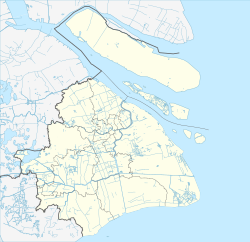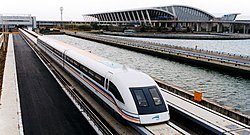| Airlines | Destinations |
|---|
| 9 Air | Guangzhou [24] |
| Aeroflot | Moscow–Sheremetyevo [25] |
| Air Canada | Toronto–Pearson (resumes 4 June 2026), [26] Vancouver [27] |
| Air China | Bangkok–Suvarnabhumi, [28] Barcelona, [29] Beijing–Capital, [30] Beijing–Daxing, [31] Changchun, [32] Chengdu–Shuangliu, [33] Chengdu–Tianfu, [34] Chongqing, [35] Daqing, [36] Frankfurt, [37] Fukuoka, [38] Guangzhou, [39] Guilin, [40] Haikou, [41] Hanoi, [42] Hohhot, [43] Jiamusi, [44] Kunming, [45] London–Gatwick, [46] Milan–Malpensa, [47] Munich, [48] Sendai, [49] Shenyang, [50] Shenzhen, [51] Singapore, [52] Taipei–Taoyuan, [53] Tianjin, [54] Tokyo–Narita, [55] Ürümqi, [56] Wenzhou, [57] Xi'an [58] Xilinhot, [59] Xining, [60] Zhanjiang, [61] Zhuhai [62] |
| Air France | Paris–Charles de Gaulle [63] |
| Air India | Delhi (resumes 1 February 2026) [64] |
| Air Macau | Macau [65] |
| Air New Zealand | Auckland [66] |
| Air Serbia | Belgrade [67] |
| All Nippon Airways | Osaka–Kansai, [68] Tokyo–Haneda, [69] Tokyo–Narita [70] |
| AirAsia | Kota Kinabalu [71] |
| AirAsia X | Kuala Lumpur–International [72] |
| American Airlines | Dallas/Fort Worth [73] |
| Asiana Airlines | Seoul–Incheon [74] |
| Aurora | Khabarovsk (begins 24 December 2025) [75] |
| Austrian Airlines | Vienna [76] |
| Beijing Capital Airlines | Lijiang, [77] Xishuangbanna [78] |
| British Airways | London–Heathrow [79] |
| Cathay Pacific | Hong Kong [80] |
| Cebu Pacific | Manila [81] |
| Chengdu Airlines | Chengdu–Shuangliu, [82] Chengdu–Tianfu, [83] Yueyang [83] |
| China Airlines | Kaohsiung, [84] Taipei–Taoyuan [85] |
| China Eastern Airlines | Abu Dhabi, [86] Almaty, [87] Altay, [88] Amsterdam, [89] Auckland, [90] Bangkok–Suvarnabhumi, [91] Barcelona, [92] Beijing–Capital, [88] Beijing–Daxing, [93] Brisbane, [94] Buenos Aires–Ezeiza, [95] Busan, [96] Cairo, [97] Cebu, [98] Changbaishan, [99] Chengdu–Shuangliu, [100] Chengdu–Tianfu, [88] Chiang Mai, [101] Chongqing, [102] Colombo–Bandaranaike, [103] Copenhagen, [104] Daegu, [105] Dali, [106] Dalian, [107] Daqing, [108] Dazhou, [109] Delhi, [110] Denpasar, [111] Dubai–International, [112] Frankfurt, [113] Fukuoka, [114] Fuyang, [115] Fuzhou, [116] Geneva, [117] Guangzhou, [88] Guilin, [118] Guiyang, [119] Haikou, [88] Hanamaki, [120] Hanoi, [121] Hangzhou, [122] Harbin, [123] Hefei, [124] Helsinki, [125] Hiroshima, [126] Ho Chi Minh City, [127] Hohhot, [128] Hong Kong, [80] Istanbul, [90] Jakarta–Soekarno-Hatta, [129] Jeju, [130] Jiamusi, [131] Jiayuguan, [132] Jieyang, [133] Jinan, [134] Jinggangshan, [135] Jingzhou, [136] Kagoshima, [137] [138] Karamay, [139] Kazan, [140] Komatsu, Korla, [141] Kuala Lumpur–International, [142] Kunming, [143] Lanzhou, [144] Lijiang, [145] Lincang, [88] Lishui, [146] London–Gatwick, [147] London–Heathrow, [90] Los Angeles, [148] Macau, [149] Madrid, [90] Malé, [150] Mangshi, [151] Manila, [152] Melbourne, [90] Milan–Malpensa, [153] Moscow–Sheremetyevo, [90] [154] Nagasaki, [155] Nagoya–Centrair, [156] Naha, [157] Nanchang, [158] Nanchong, [159] Nanjing, [160] Nanning, [161] New York–JFK, [162] Ordos, [163] Osaka–Kansai, [164] Paris–Charles de Gaulle, [165] Penang, [166] Phnom Penh, [167] Phuket, [168] Qingdao, [169] Qionghai, [170] Quanzhou, [171] Riyadh, [172] Rome–Fiumicino, [173] Ruijin, [174] Saint Petersburg, [175] San Francisco, [176] Sanya, [177] Sapporo–Chitose, [178] Seoul–Incheon, [179] Shenyang, [180] Shenzhen, [181] Shijiazhuang, [163] Singapore, [182] Sydney, [90] Taipei–Taoyuan, [183] Tianjin, [184] Tokyo–Haneda, [185] Tokyo–Narita, [186] Toronto–Pearson, [187] Ürümqi, [188] Vancouver, [189] Venice, [190] [191] Vientiane, [192] Wenzhou, [193] Wuhan, [194] Xi'an, [195] Xiamen, [196] Xining, [60] Xinyang, [100] Xishuangbanna, [197] Yan'an, [198] Yantai, [199] Yinchuan, [200] Yiwu, [201] Zhanjiang, [202] Zhengzhou, [203] Zhuhai [62] |
| China Southern Airlines | Beijing–Daxing, [204] Changchun, [205] Changsha, [206] Chengdu–Tianfu, [207] Chongqing, [208] Guangzhou, [209] Haikou, [210] Ho Chi Minh City, [211] Kunming, [212] Nanning, [213] Nanyang, [214] Qingdao, [215] Sanya, [216] Shenyang, [217] Seoul–Incheon, [218] Tokyo–Narita, [219] Ürümqi, [220] Wuhan, [221] Zhengzhou, [222] Zhuhai [223] |
| China United Airlines | Baicheng, [224] Beijing–Daxing, [225] Foshan, [226] Hailar, [227] Huizhou [228] |
| Delta Air Lines | Detroit, [229] Los Angeles, [230] Seattle/Tacoma [231] |
| Donghai Airlines | Shenzhen [232] |
| Eastar Jet | Jeju, [233] Seoul–Incheon [234] [235] |
| Egyptair | Cairo [236] |
| Emirates | Dubai–International [237] |
| EVA Air | Kaohsiung, [84] Taipei–Taoyuan [85] |
| Finnair | Helsinki [238] |
| Garuda Indonesia | Jakarta–Soekarno-Hatta [239] |
| Gulf Air | Bahrain [240] |
| Hainan Airlines | Beijing–Capital, [241] Brussels, [242] Changsha, [243] Chengdu–Tianfu, [244] Chongqing, [245] Guangzhou, [246] Sanya, [247] Shenzhen, [248] Xi'an [249] |
| Hebei Airlines | Shijiazhuang [250] |
| Himalaya Airlines | Kathmandu [251] |
| Hong Kong Airlines | Hong Kong [80] |
| Japan Airlines | Osaka–Kansai, [252] Tokyo–Haneda, [253] Tokyo–Narita [254] |
| Jeju Air | Busan [255] |
| Jetstar Japan | Tokyo–Narita [256] |
| Juneyao Air | Athens, [257] Bangkok–Suvarnabhumi, [258] Beijing–Daxing, [259] Bijie, [260] Brussels, [261] Changchun, [262] Changsha, [263] Chengdu–Tianfu, [264] Chifeng, [265] Chongqing, [266] Denpasar, [267] Fukuoka, [268] Fuzhou, [269] Guangzhou, [270] Guilin, [40] Haikou, [271] Hanoi, [272] Helsinki [273] Ho Chi Minh City, [272] Hong Kong, [274] Hohhot, [275] Jeju, [276] Kaohsiung, [277] Kobe, [278] Kuala Lumpur–International, [279] Lanzhou, [280] Lijiang, [281] Longnan, [282] Manchester, [261] Melbourne, [283] Nagoya–Centrair, [284] Nanning, [285] Osaka–Kansai, [286] Penang, [287] Qingdao, [288] Qingyang, [289] Sanya, [290] Sapporo–Chitose, [291] Shenyang, [292] Shuozhou, [293] Singapore, [294] Sydney, [283] Taipei–Taoyuan, [295] Tokyo–Haneda, [296] Tokyo–Narita, [297] Ulanhot, [298] Ürümqi, [299] Vladivostok, [300] Wuhan, [301] Xiamen, [302] Xingtai, [303] Xishuangbanna, [304] Yingkou, [305] Yulin (Guangxi), [306] Yulin (Shaanxi), [307] Zhengzhou [308] |
| KLM | Amsterdam [309] |
| Korean Air | Busan, [310] [311] Seoul–Incheon [74] |
| Kunming Airlines | Kunming [312] |
| Lao Airlines | Vientiane [313] [314] |
| Loong Air | Aksu, [315] Chengdu–Tianfu, [316] Sanya, [317] Yinchuan [315] |
| Lucky Air | Xishuangbanna [318] |
| Lufthansa | Frankfurt, [319] Munich [320] |
| Mahan Air | Tehran–Imam Khomeini [321] |
| Malaysia Airlines | Kuala Lumpur–International [322] |
| MIAT Mongolian Airlines | Ulaanbaatar [323] |
| Peach | Osaka–Kansai, [324] Tokyo–Haneda, [325] |
| Philippine Airlines | Manila [326] |
| Qatar Airways | Doha [327] |
| Qingdao Airlines | Qingdao [328] |
| Rossiya Airlines | Vladivostok [329] |
| S7 Airlines | Irkutsk, [330] Novosibirsk (begins 29 March 2026), [331] Vladivostok [332] |
| SCAT Airlines | Şymkent [333] |
| Shandong Airlines | Jinan, [334] Qingdao [335] |
| Shanghai Airlines | Bangkok–Suvarnabhumi, [336] Baotou, [337] Budapest, [338] Busan, [339] Casablanca, [340] Changchun, [341] Changsha, [342] Chengdu–Tianfu, [100] Chongqing, [100] Fukuoka, [343] Guangzhou, [344] Guilin, [40] Haikou, [345] Hengyang, [346] Hong Kong, [347] Jieyang, [348] Kota Kinabalu, [349] Kuala Lumpur–International, [350] Lanzhou, [351] Marseille, [352] Mianyang, [353] Mudanjiang, [354] Nagoya–Centrair, [355] Nanning, [356] Ningbo, [357] Osaka–Kansai, [358] Penang, [359] Phuket, [360] Sanya, [361] Shenyang, [362] Shiyan, [363] Tianjin, [364] Tokyo–Haneda, [365] Ürümqi, [366] Weihai, [367] Wenzhou, [368] Wuzhou, [369] Xiamen, [370] Xining, [60] Zhanjiang, [371] Zhengzhou, [372] Zhuhai [373] |
| Shenzhen Airlines | Guangzhou, [374] Shenzhen [375] |
| Sichuan Airlines | Chengdu–Shuangliu, [376] Chengdu–Tianfu, [377] Chongqing [378] Ürümqi, [379] Xi'an [380] |
| Singapore Airlines | Singapore [381] |
| Sky Angkor Airlines | Phnom Penh [382] |
| Spring Airlines | Bangkok–Suvarnabhumi, [383] Busan, [384] Changchun, [385] Chiang Mai, [386] Chongqing, [387] Enshi, [388] Fukuoka, [389] Hanoi, [390] Heze, [391] Ho Chi Minh City, [392] Jeju, [393] Kaohsiung, [394] Kuala Lumpur–International, [395] Lanzhou, [396] Lijiang, [397] Macau, [398] Mianyang, [399] Mohe, [400] Naha, [401] Osaka–Kansai, [402] Phnom Penh, [403] Sapporo–Chitose, [404] Shenyang, [405] Shihezi, [406] Singapore, [407] Songyuan, [408] Takamatsu, [409] Tokyo–Haneda, [410] Tokyo–Narita, [411] Xishuangbanna [412] |
| Spring Japan | Tokyo–Narita [413] |
| Suparna Airlines | Chongqing, [414] Guiyang, [415] Haikou, [415] Hami, [58] Harbin, [415] Langzhong, [416] Luoyang, [415] Qingdao, [416] Quanzhou, [417] Sanya, [418] Shenyang, [419] Shenzhen, [420] Xingtai, [415] Zhuhai [421] |
| Swiss International Air Lines | Zurich [422] |
| Thai AirAsia | Bangkok–Don Mueang [423] |
| Thai AirAsia X | Bangkok–Don Mueang [424] [425] |
| Thai Airways International | Bangkok–Suvarnabhumi [424] |
| Thai Lion Air | Bangkok–Don Mueang [424] |
| Thai VietJet Air | Bangkok–Suvarnabhumi [424] |
| Tianjin Airlines | Dalian, [426] Tianjin, [427] Weihai [426] |
| Tibet Airlines | Chengdu–Shuangliu [428] |
| TransNusa | Manado [429] |
| Turkish Airlines | Istanbul [430] |
| United Airlines | Los Angeles, [431] San Francisco [432] |
| Urumqi Air | Ürümqi, [433] Yutian [433] |
| VietJet Air | Hanoi, [434] [435] Ho Chi Minh City [436] [437] |
| Vietnam Airlines | Hanoi, [434] Ho Chi Minh City [436] |
| West Air | Chongqing [438] |
| XiamenAir | Beijing–Daxing, [439] Fuzhou, [440] Shenyang, [441] Tianjin, [442] Xiamen, [443] Yinchuan [200] |














